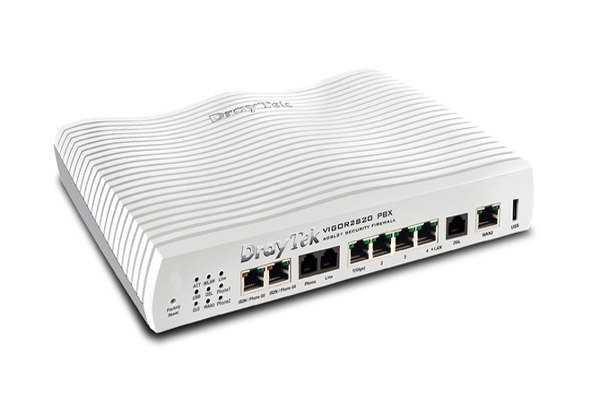Draytek VigorIPPBX 2820 review
We review the Draytek VigorIPPBX 2820 to see if its combined router and IP PBX capabilities make life easier than buying two separate products.

This device's IP PBX feature set is ideal for a small office. Although it's not as powerful or flexible as advanced dedicated IP PBX systems, it's incredibly simple to set up and did everything we asked of it. Call quality was excellent and we had no problem using it with our usual VoIP phones and softphones. The Vigor's capabilities as a router are as simple and effective as its IP PBX features. There's remarkably little on market to compare it to, as this is the first device we've seen from a major manufacturer to combine a router with an IP PBX. At around £370, it costs a little over twice as much as Draytek's standard Vigor 2820 router. Although it may be possible to buy a similarly specified dedicated IP PBX appliance and a separate router for a little less, configuration will certainly not be as simple as it has proved to be with the VigorIPPBX.

VoIP telephony is a convenient and inexpensive way to provide your business with multiple phone lines, but rolling services of this sort out to an entire office typically requires IP PBX call routing hardware and software that is often expensive to buy, complex to configure, or both.
Draytek's VigorIPPBX 2820 is a combined router and IP PBX, which means that a single piece of equipment can handle your telephony system as well as your computer network and WAN connection.
The device has a USB port, Ethernet WAN, ADSL, four Ethernet LAN ports (three 10/100 and one 10/100/1000), two ISDN ports and analogue phone in and out ports. The current firmware allows you to make and receive called using the analogue line, and use it as a failover if power is cut, but the analogue line can't be configured for used as an IP extension - Draytek promises an update to correct this in the near future. The single Gigabit LAN port means that you'll need to invest in a Gigabit switch if you wish to connect multiple machines to a high-speed local network.
Configuration is remarkably simple, thanks to a clean, easy-to-use web interface with a handy quick setup wizard. The wizard prompts you to first set your router's password before selecting your WAN interface. You can choose between WAN1, associated with the router's ADSL port, or WAN2, which can be configured to use either an Ethernet connection or a mobile broadband link via the USB port. If you're using multiple connections, it's a good idea to give them a display name at this point to make it easier to distinguish between them during later configuration.
After saving your settings, any additional configuration is done via the VigorIPPBX 's comprehensive settings screens. These are arranged clearly, although notes on the features and their usage aren't included in the interface itself. You can have two simultaneous WAN connections, which can be configured as either one active connection with a failover to take over if it goes down or as a pair of simultaneous connections for improved throughput. Unfortunately, WAN1 is permanently associated with the ADSL port, so you can't use an Ethernet connection with a 3G failover, as both can only be set up on WAN2.
Get the ITPro daily newsletter
Sign up today and you will receive a free copy of our Future Focus 2025 report - the leading guidance on AI, cybersecurity and other IT challenges as per 700+ senior executives
K.G. is a journalist, technical writer, developer and software preservationist. Alongside the accumulated experience of over 20 years spent working with Linux and other free/libre/open source software, their areas of special interest include IT security, anti-malware and antivirus, VPNs, identity and password management, SaaS infrastructure and its alternatives.
You can get in touch with K.G. via email at reviews@kgorphanides.com.
-
 Westcon-Comstor and Vectra AI launch brace of new channel initiatives
Westcon-Comstor and Vectra AI launch brace of new channel initiativesNews Westcon-Comstor and Vectra AI have announced the launch of two new channel growth initiatives focused on the managed security service provider (MSSP) space and AWS Marketplace.
By Daniel Todd Published
-
 Third time lucky? Microsoft finally begins roll-out of controversial Recall feature
Third time lucky? Microsoft finally begins roll-out of controversial Recall featureNews The Windows Recall feature has been plagued by setbacks and backlash from security professionals
By Emma Woollacott Published
-
 The UK government wants quantum technology out of the lab and in the hands of enterprises
The UK government wants quantum technology out of the lab and in the hands of enterprisesNews The UK government has unveiled plans to invest £121 million in quantum computing projects in an effort to drive real-world applications and adoption rates.
By Emma Woollacott Published